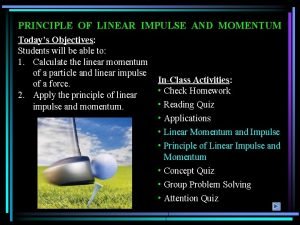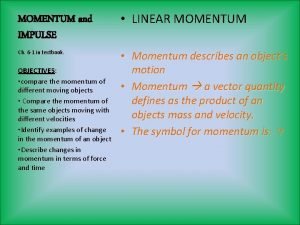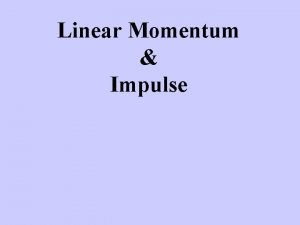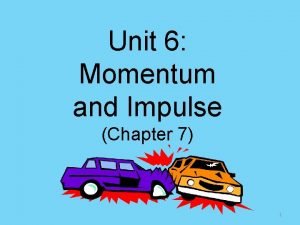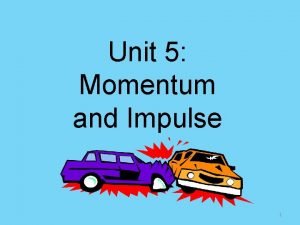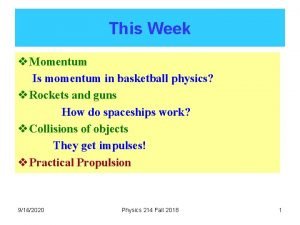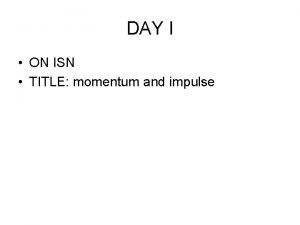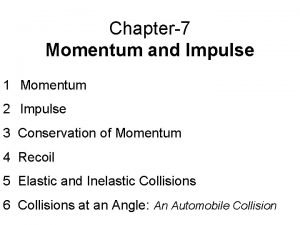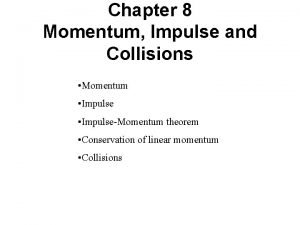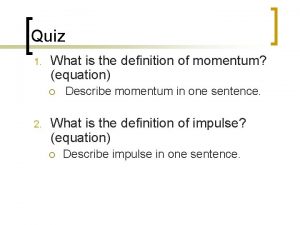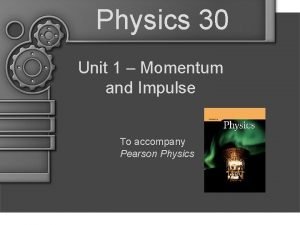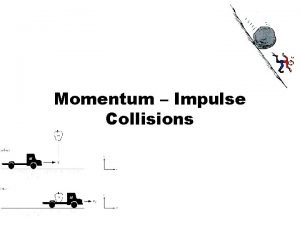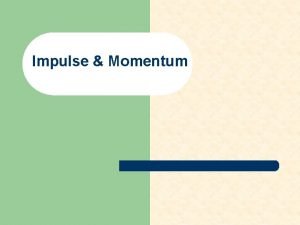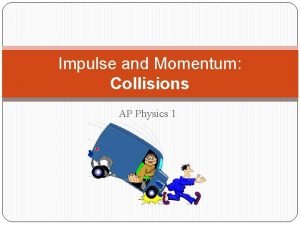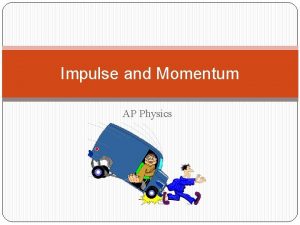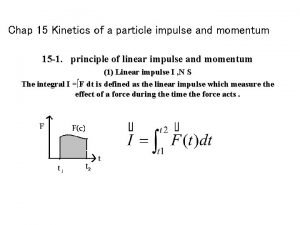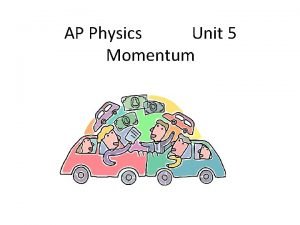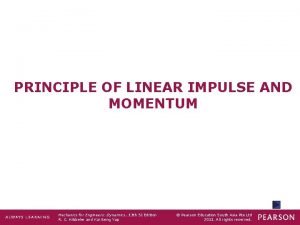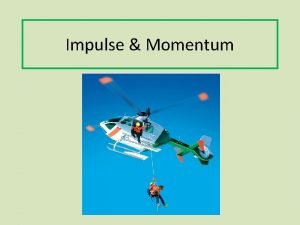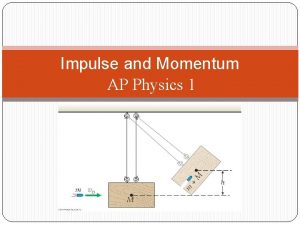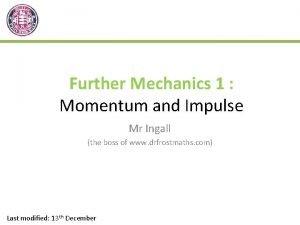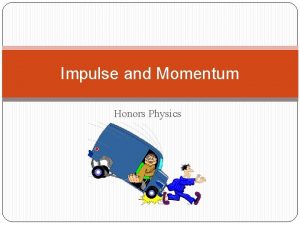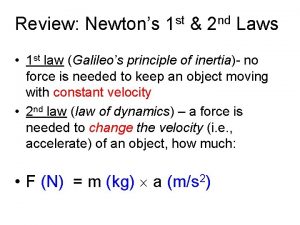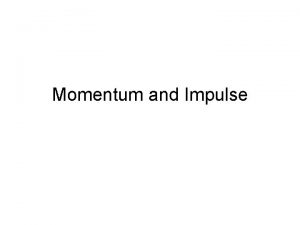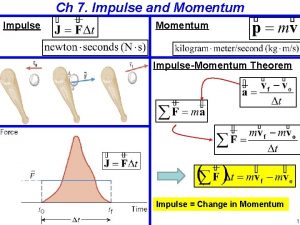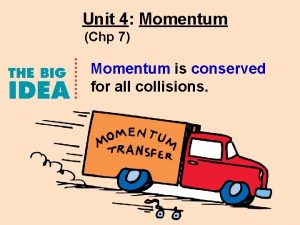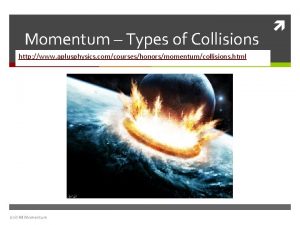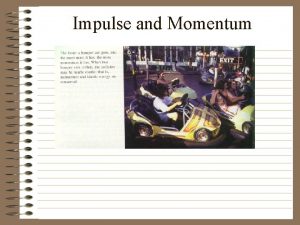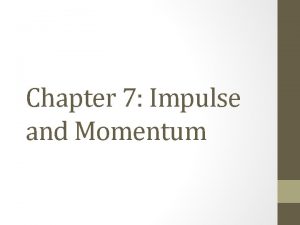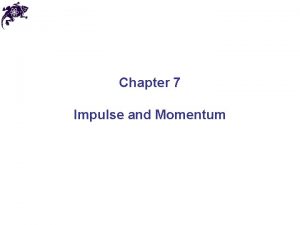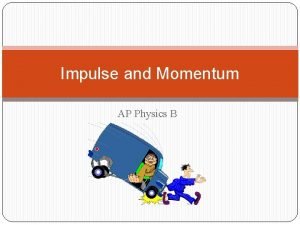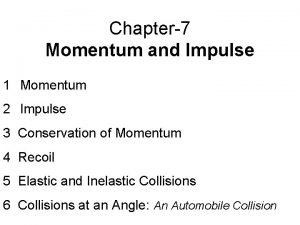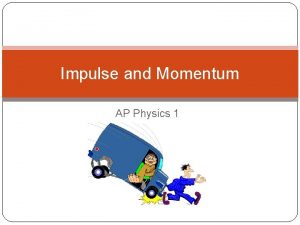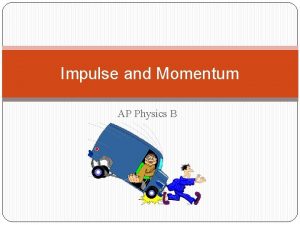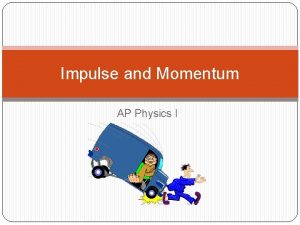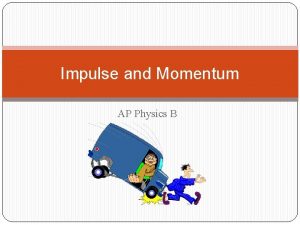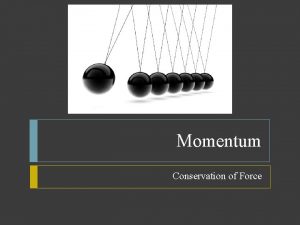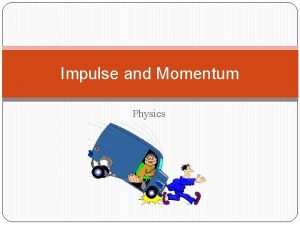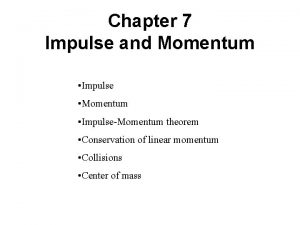MOMENTUM and IMPULSE LINEAR MOMENTUM Ch 6 1

































- Slides: 33

MOMENTUM and IMPULSE • LINEAR MOMENTUM Ch. 6 -1 in textbook. • Momentum describes an object’s motion • Momentum a vector quantity defines as the product of an objects mass and velocity. • The symbol for momentum is: OBJECTIVES: • compare the momentum of different moving objects • Compare the momentum of the same objects moving with different velocities • Identify examples of change in the momentum of an object • Describe changes in momentum in terms of force and time

Linear Momentum… • The equationfor momentum is: = mv Where is momentum, momentum m is mass, and v is velocity.

Linear Momentum • Momentum is a VECTOR QUANTITY. • It’s direction matches that of its velocity. • The SI units of momentum are Kg x m/s

Linear Momentum • Think about coasting down a steep hill on your bike… – The faster you move, the more momentum you have and the more difficult it is to come to a stop. • At the same speed…the larger the mass of the object the more momentum that object has. 50 mph

Sample Problem • A 2250 kg truck has a velocity of 25 m/s to the east. What is the momentum of the truck? GIVEN FORMULA SUBSTITUTION ANSWER and UNITS M = 2250 kg =mxv = 2250 (25) 56250 = V = 25 m/s = 5. 6 x 104 Kg x m/s to the east.

Practice Problems… • A 21 kg child is riding a 5. 9 kg bike with a velocity of 4. 5 m/s to the northwest. – A. What is the total momentum of the child and bike together? – B. What is the momentum of the child? – C. What is the momentum of the bike?

A 21 kg child is riding a 5. 9 kg bike with a velocity of 4. 5 m/s to the northwest. A. What is the total momentum of the child and bike together? B. What is the momentum of the child? C. What is the momentum of the bike? GIVEN M(child) = 21 kg M (bike) = 5. 9 kg V = 4/5 m/s FORMULA SUB = mv = (21 +5. 9)(4. 5) = (26. 9)(4. 5) ANS/UNITS = 121. 05 Kg x m/s to the northwest

A 21 kg child is riding a 5. 9 kg bike with a velocity of 4. 5 m/s to the northwest. A. What is the total momentum of the child and bike together? B. What is the momentum of the child? C. What is the momentum of the bike? GIVEN M(child) = 21 kg M (bike) = 5. 9 kg V = 4/5 m/s FORMULA SUB = mv = (21)(4. 5) ANS/UNITS = 94 Kg x m/s to the northwest

A 21 kg child is riding a 5. 9 kg bike with a velocity of 4. 5 m/s to the northwest. A. What is the total momentum of the child and bike together? B. What is the momentum of the child? C. What is the momentum of the bike? GIVEN M(child) = 21 kg M (bike) = 5. 9 kg V = 4/5 m/s FORMULA SUB = mv = (5. 9)(4. 5) ANS/UNITS = 27 Kg x m/s to the northwest

Change in Momentum • A change in momentum takes force and time. F= t Force = Change in momentum time interval

IMPULSE MOMENTUM THEOREM • (Page 210 in textbook) • Impulse for a constant external force, the product of the force and the time over which it acts on an object. • Impulse momentum theorem: F t= or F t = = mv(final) – mv(initial)

IMPULSE MOMENTUM THEOREM • A 1400 kg car moving westward with a velocity of 15 m/s collides with a utility pole and is brought to rest in 0. 30 s. Find the magnitude of the force exerted on the car during the collision.

A 1400 kg car moving westward with a velocity of 15 m/s collides with a utility pole and is brought to rest in 0. 30 s. Find the magnitude of the force exerted on the car during the collision. GIVEN FORMULA SUB M = 1400 kg F t = = mv(final) – mv(initial) F = (1400)(0) – (1400)(15) 0. 30 Vi = 15 m/s F = mv(final) – mv(initial) t F = 21000 kg x m/s 0. 30 Vf = 0 t =. 30 s ANS/UNIT F = 70000 N to the east

Figure 6 -3 in text… • Stopping times and distance depend on the impulsemomentum theorem. • Two trucks with the same mass traveling at the same speed, but one is loaded down… • The truck with a load in the bed, MUST undergo a GREATER change in momentum than the truck without a load when arriving upon the same stop sign.

Figure 6 -3 in text… • The loaded down truck’s momentum is twice as great, so its change in momentum is also twice as great. The applied forces are the same, so the time period must be twice as great as well. =F t

Figure 6 -3 in text… • How do the stopping distances compare? – The loaded truck’s time period is twice as great while its acceleration is half as much (F-ma). – Because x = Vi t + ½ a t 2 – the loaded truck’s stopping distance is 2 times as great as the empty trucks.

A 2250 kg car traveling to the west slows down uniformly from 20. 0 m/s to 5. 0 m/s. How long does it take the car to decelerate if the force on the car is 8450 N to the east? How far does the car travel during deceleration?

A 2250 kg car traveling to the west slows down uniformly from 20. 0 m/s to 5. 0 m/s. How long does it take the car to decelerate if the force on the car is 8450 N to the east? How far does the car travel during deceleration? GIVEN FORMULA SUB M = 2250 kg F t = = mv(final) – mv(initial) t= (2250)(-5) – (2250)(-20) 8450 Vi = -20 m/s (neg b/c going west) t = mv(final) – mv(initial) F t = 33750 kg x m/s 8450 kg x m 2/s 2 Vf = -5 m/s F = 8450 N to the east (+) ANS/UNIT t= 3. 99 s

A 2250 kg car traveling to the west slows down uniformly from 20. 0 m/s to 5. 0 m/s. How long does it take the car to decelerate if the force on the car is 8450 N to the east? How far does the car travel during deceleration? GIVEN M = 2250 kg Vi = -20 m/s (neg b/c going west) Vf = -5 m/s T=4 FORMULA x = ½ (vi(final) + v(initial))t SUB ANS/UNIT x= ½ (-20 - 5) (3. 99) X= -50 m or 50 m to the West

A change in momentum over a longer time requires less force. • If the speed of a particle is doubled, then the momentum increases by a factor of 2. • The thespeed of a particle is doubled, then the KE increases by a factor of 4.

Impulse and Momentum • What is the relationship? ? ? Impulse is equivalent to a change in momentum. When comparing the momentum of 2 moving objects… The less massive object will have less momentum if the velocities are the same.

Which has the GREATEST momentum? A: Turtle with a mass of 91 kg moving at 1. 4 m/s B: 1. 8 kg Roadrunner moving at a 6. 7 m/s C: Hare with a mass of 2. 7 kg moving at 7 m/s D: 270 kg Tortoise moving at 0. 5 m/s

Which has the GREATEST momentum? A: Turtle with a mass of 91 kg moving at 1. 4 m/s 127. 4 kg*m/s B: 1. 8 kg Roadrunner moving at a 6. 7 m/s 12. 06 kg*m/s C: Hare with a mass of 2. 7 kg moving at 7 m/s 18. 9 kg*m/s D: 270 kg Tortoise moving at 0. 5 m/s 135 kg*m/s

Review… • If the speed of a particle is doubled… – By what factor is its momentum changed? – What happens to its KE?

Review • 1 - Momentum increases by a factor of 2 • KE increases by a factor of 4 • Why the difference?

HOMEWORK • Page 209 # 1 and 3 • Page 211 # 1 and 3

CONSERVATION of MOMENTUM • ρ1 i + ρ2 i = ρ1 f + ρ2 f • m 1 v 1 i + m 2 v 2 i = m 1 v 1 f + m 2 v 2 f TOTAL INITIAL MOMENTUM = TOTAL FINAL MOMENTUM

COPY DOWN IN NOTES… • The total momentum of all objects interacting with one another remains constant regardless of the nature of the forces between the objects.

READING • Read Page 216 -217 on momentum conservation • Understand that momentum is conserved during collisions AND for objects that are pushing away from each other.

EXAMPLE • 2 Skaters pushing away from each other (fig 6 -7) Both initially at rest with a momentum of ρ1 i = ρ2 i =0 When they push away from each other, they move in opposite directions with EQUAL but OPPOSITE momentum so that the final momentum is also 0. ρ1 f + ρ2 f

SAMPLE • A 76 kg boater, initially at rest in a stationary 45 kg boat, steeps out of the boat and onto the dock. If the boater moves out of the boat with a velocity of 2. 5 m/s to the right, what is the final velocity of the boat? • m 1 i v 1 i + m 2 i v 2 i =m 1 f v 1 f +m 2 f v 2 f

Solution • m 1 i v 1 i + m 2 i v 2 i =m 1 f v 1 f +m 2 f v 2 f • 190 kg m/s + 45 kg ( v 2 f) = 0 • 45 kg ( v 2 f) = -190 kg m/s • ( v 2 f) = -190 kg m/s 45 kg ( v 2 f) = -4. 2 m/s The negative sign indicates that the boat is moving left. (opposite direction of the boater)

HOMEWORK • Page 219: 1 -2 • Page 221: 1 and 3
 Linear momentum and linear impulse
Linear momentum and linear impulse Linear impulse momentum equation
Linear impulse momentum equation A 2250 kg car traveling to the west slows down
A 2250 kg car traveling to the west slows down Linear momentum
Linear momentum Work energy theorem
Work energy theorem Unit 6 momentum and impulse
Unit 6 momentum and impulse Unit of momentum and impulse
Unit of momentum and impulse How to find initial momentum
How to find initial momentum The importance of momentum
The importance of momentum Poem about impulse and momentum
Poem about impulse and momentum Importance of momentum and impulse
Importance of momentum and impulse Impulse momentum
Impulse momentum Unit for momentum
Unit for momentum Impulse and momentum in sports
Impulse and momentum in sports Momentum units physics
Momentum units physics Momentum and impulse physics 30
Momentum and impulse physics 30 The momentum of an object at rest
The momentum of an object at rest Impulse symbol
Impulse symbol Impulse and momentum
Impulse and momentum Ap physics 1 momentum and impulse
Ap physics 1 momentum and impulse Ap physics momentum and impulse
Ap physics momentum and impulse Granny whizzes around the rink and is suddenly
Granny whizzes around the rink and is suddenly Kinetics of a particle: impulse and momentum
Kinetics of a particle: impulse and momentum Unit 5 momentum 5.a center of mass
Unit 5 momentum 5.a center of mass Dynamics impulse and momentum solved problems
Dynamics impulse and momentum solved problems Principle of angular impulse and momentum
Principle of angular impulse and momentum What is momentum in physics
What is momentum in physics Further mechanics 1 unit test 1 momentum and impulse
Further mechanics 1 unit test 1 momentum and impulse Relationship between momentum and impulse
Relationship between momentum and impulse Impulse is measured in
Impulse is measured in How to find change in momentum
How to find change in momentum How does impulse relate to momentum
How does impulse relate to momentum The impulse-momentum relationship is a direct result of
The impulse-momentum relationship is a direct result of Types of collision
Types of collision

